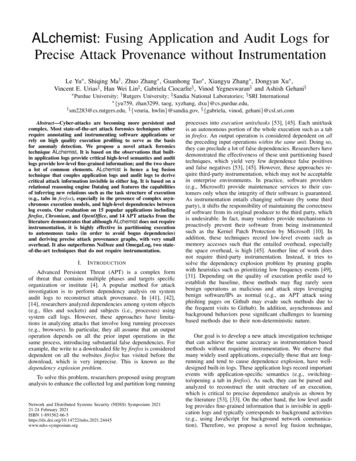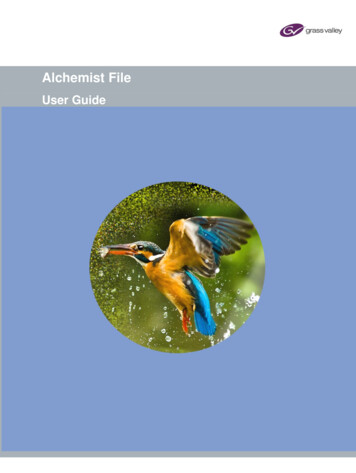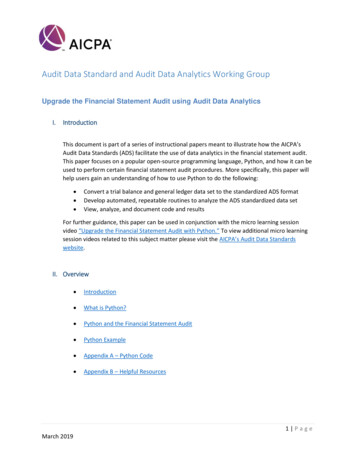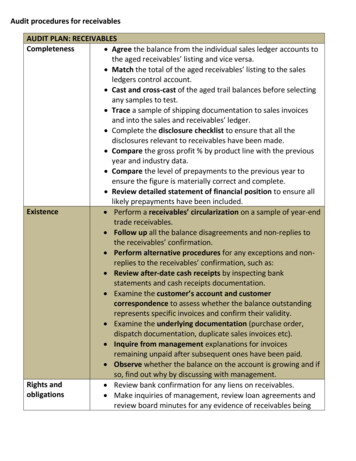
Transcription
ALchemist: Fusing Application and Audit Logs forPrecise Attack Provenance without InstrumentationLe Yu , Shiqing Ma† , Zhuo Zhang , Guanhong Tao , Xiangyu Zhang , Dongyan Xu ,Vincent E. Urias‡ , Han Wei Lin‡ , Gabriela Ciocarlie§ , Vinod Yegneswaran§ and Ashish Gehani§ PurdueUniversity; † Rutgers University; ‡ Sandia National Laboratories; § SRI International {yu759, zhan3299, taog, xyzhang, dxu}@cs.purdue.edu,† sm2283@cs.rutgers.edu, ‡ {veuria, hwlin}@sandia.gov, § {gabriela, vinod, gehani}@csl.sri.comAbstract—Cyber-attacks are becoming more persistent andcomplex. Most state-of-the-art attack forensics techniques eitherrequire annotating and instrumenting software applications orrely on high quality execution profiling to serve as the basisfor anomaly detection. We propose a novel attack forensicstechnique ALchemist. It is based on the observations that builtin application logs provide critical high-level semantics and auditlogs provide low-level fine-grained information; and the two sharea lot of common elements. ALchemist is hence a log fusiontechnique that couples application logs and audit logs to derivecritical attack information invisible in either log. It is based on arelational reasoning engine Datalog and features the capabilitiesof inferring new relations such as the task structure of execution(e.g., tabs in firefox), especially in the presence of complex asynchronous execution models, and high-level dependencies betweenlog events. Our evaluation on 15 popular applications includingfirefox, Chromium, and OpenOffice, and 14 APT attacks from theliterature demonstrates that although ALchemist does not requireinstrumentation, it is highly effective in partitioning executionto autonomous tasks (in order to avoid bogus dependencies)and deriving precise attack provenance graphs, with very smalloverhead. It also outperforms NoDoze and OmegaLog, two stateof-the-art techniques that do not require instrumentation.I.I NTRODUCTIONAdvanced Persistent Threat (APT) is a complex formof threat that contains multiple phases and targets specificorganization or institute [4]. A popular method for attackinvestigation is to perform dependency analysis on systemaudit logs to reconstruct attack provenance. In [41], [42],[14], researchers analyzed dependencies among system objects(e.g., files and sockets) and subjects (i.e., processes) usingsystem call logs. However, these approaches have limitations in analyzing attacks that involve long running processes(e.g., browsers). In particular, they all assume that an outputoperation depends on all the prior input operations in thesame process, introducing substantial false dependencies. Forexample, the write to a downloaded file by firefox is considereddependent on all the websites firefox has visited before thedownload, which is very imprecise. This is known as thedependency explosion problem.To solve this problem, researchers proposed using programanalysis to enhance the collected log and partition long runningNetwork and Distributed Systems Security (NDSS) Symposium 202121-24 February 2021ISBN .24445www.ndss-symposium.orgprocesses into execution units/tasks [53], [45]. Each unit/taskis an autonomous portion of the whole execution such as a tabin firefox. An output operation is considered dependent on allthe preceding input operations within the same unit. Doing so,they can preclude a lot of false dependencies. Researchers havedemonstrated the effectiveness of these unit partitioning basedtechniques, which yield very few dependence false positivesand false negatives [53], [45]. However, these approaches require third-party instrumentation, which may not be acceptablein enterprise environments. In practice, software providers(e.g., Microsoft) provide maintenance services to their customers only when the integrity of their software is guaranteed.As instrumentation entails changing software (by some thirdparty), it shifts the responsibility of maintaining the correctnessof software from its original producer to the third party, whichis undesirable. In fact, many vendors provide mechanisms toproactively prevent their software from being instrumentedsuch as the Kernel Patch Protection by Microsoft [10]. Inaddition, these techniques record low-level events such asmemory accesses such that the entailed overhead, especiallythe space overhead, is high [45]. Another line of work doesnot require third-party instrumentation. Instead, it tries tosolve the dependency explosion problem by pruning graphswith heuristics such as prioritizing low frequency events [49],[31]. Depending on the quality of execution profile used toestablish the baseline, these methods may flag rarely seenbenign operations as malicious and attack steps leveragingbenign software/IPs as normal (e.g., an APT attack usingphishing pages on Github may evade such methods due tothe frequent visits to Github). In addition, asynchronous andbackground behaviors pose significant challenges to learningbased methods due to their non-deterministic nature.Our goal is to develop a new attack investigation techniquethat can achieve the same accuracy as instrumentation basedmethods without requiring instrumentation. We observe thatmany widely used applications, especially those that are longrunning and tend to cause dependence explosion, have welldesigned built-in logs. These application logs record importantevents with application-specific semantics (e.g., switchingto/opening a tab in firefox). As such, they can be parsed andanalyzed to reconstruct the unit structure of an execution,which is critical to precise dependence analysis as shown bythe literature [53], [33]. On the other hand, the low level auditlog provides fine-grained information that is invisible in application logs and typically corresponds to background activities(e.g., using JavaScript for background network communication). Therefore, we propose a novel log fusion technique,
ALchemist, that couples application logs and the audit log,to produce precise attack provenance. It does not require anyinstrumentation and the entailed overhead is low compared toexisting techniques. During attack investigation, ALchemistfirst normalizes the raw application logs and the audit log to acanonical form such that their correlations can be inferred. Thecanonical form is general such that it can express all the execution models of common applications, including those havingcomplex asynchronous/background behaviors. The canonicallog entries are loaded into a Datalog engine [38] to derivenew relations based on a set of pre-defined rules, which wecall the log fusion rules. Precise dependency graphs can beeasily constructed from the inferred relations. In summary, wemake the following contributions:sections from concurrent tasks and dependences invisible ineither application log or the audit log alone, through log fusion.Please see our comparative results in Section V-D.NoDoze [31] uses unsupervised learning to predict if adependence edge is normal. It only includes the abnormaledges in the provenance graph. In our example, if x.x.x.x israrely visited, it will be included. With NoDoze, most normalbrowsing behaviors (e.g., visiting CNN.com) are recognizedas normal and precluded. While it can substantially reducethe graph size, depending on the quality of normal behavior profile, it may have both false positives (e.g., includingbenign websites that people rarely visit as part of the attackgraph) and false negatives (e.g., missing malicious behaviorsinvolving benign sites/IPs/applications). Similar to OmegaLog,it can hardly handle bogus dependencies caused by asynchronous/background behaviors. We propose a novel log fusion technique that features thecapabilities of inferring new relations from existing logs. We develop a set of parsers that can normalize variouslogs to an expressive canonical form. We study the execution models of a set of popular applications from [54],[53], [45], [52] and their built-in application logs, anddetermine that their executions can be expressed by thecanonical form that preserves the critical unit related information. In addition, we study the log format changes ofthese applications (Appendix A) and find that log formatsrarely change, much less frequently compared to softwarereleases. Note that for instrumentation based techniques,each software release entails re-instrumentation. We develop a comprehensive set of log fusion rulesgeneral for all applications. We devise a demand-driveninference algorithm to handle a large volume of log eventsin the Datalog engine. We develop a prototype on Linux and evaluate it on 8machines for 7 days. The results show that ALchemistachieves 92.8% precision and 99.6% recall with only1.1% run time overhead and 6.8% storage overhead, implying that ALchemist can achieve similar accuracy andlower overhead, when compared to instrumentation basedapproaches. In the study of 14 attacks collected from theliterature, ALchemist outperforms NoDoze [31], a stateof-the-art technique that does not require instrumentation,and OmegaLog [33], another state-of-the-art techniquethat makes use of both application and audit logs.Commercial log analysis tools such as Splunk [13] andElasticsearch [8] use pre-built parsers to process unstructuredapplication built-in logs to structured databases that can bequeried. Multiple application logs can be correlated (e.g.,through common file names). However, they do not constructa canonical representation. Neither do they derive new andimplicit relations from existing ones. They are not designedfor forensics and hence they cannnot directly generate attackprovenance graphs or handle dependence explosion.Threat Model. ALchemist aims to detect attacks which exploit application vulnerabilities or leverage social engineeringtechniques to get into victim systems for data exfiltrationor manipulation. And we consider hardware or side channelrelated attacks to be out of scope of this paper. Similar to manyexisting works [19], [62], [61], [45], [44], [54], [31], [33], weassume the Linux kernel and the components associated withthe audit logging system, which may be in the user space, arepart of our trusted computing base (TCB). We also assume theapplication logs can be trusted. Note that existing works [53],[45], [33] also trust the (instrumented) applications or theirbuilt-in logs. As pointed out in [53], [45], [31], [61], althoughthe attackers can subvert applications or even the kernel suchthat logs are compromised, the subversion procedure can beprecisely captured (by the logs before they are compromised).Existing software and kernel hardening techniques (e.g., [30],[19]) can be used to secure log storage. Cryptographic hashvalues can be computed for log events (or event blocks) andstored as part of the application logs [51], [50], [16] suchthat tampering efforts can be detected. They are orthogonal toALchemist and beyond the scope of our paper.Comparison with OmegaLog, NoDoze and CommercialLog Analysis Tools. OmegaLog [33] leverages applicationlogs to recover execution paths, which can be used to partition execution to avoid dependence explosion. Particularly,a sequence of application log entries (e.g., those producedby fprintf()) can be used to recover an approximateprogram path, Repetition of such paths indicate an application is handling (independent) tasks. OmegaLog identifiessuch paths, projects each path to a corresponding audit logentry sequence, and then enables partitioning the audit log.It does not derive high level semantics from application logsexcept control flow path. Its dependence analysis is exclusivelyperformed on the audit log. As such, although it works verywell on server applications in which control flow paths ofindependent tasks do not interleave, it can hardly handleasynchronous/background behaviors that are very common incomplex applications such as firefox. In contrast, ALchemistinfers rich semantic information such as interleaving atomicII.M OTIVATIONOne day, a user receives an email with a phishing link. Sheclicks the link and a compromised software repository websiteis opened in a new tab. During page loading, a maliciousJS script is executed to download a compromised fcopy fromx.x.x.x. Later, the user executes fcopy without realizing that ithas been compromised. Upon execution, the malware copiessensitive data files to a shared folder /var/www/html. In orderto remove the attack trace, it also creates a php file cleaner.phpwhich deletes attack-related files after sending them to theattacker (i.e., site z.z.z.z). The suspicious connection to z.z.z.zis detected, leading to investigation. The example is different2
x.x.x.x x.x.x.xcopyinfo.htmlfcopy info.htmlapachez.z.z.zapacheFig. 1: Causal graph by syscall only methods (e.g., [41])16:30:12 [23104] nsObserverService (TranID 0xf4a1d5b80)UpdateCurrentTopLevelOuterTabId id 200000001(a)21:17:46 [8890] mozStorage ATTACH ‘ /.thunderbird/INBOX’21:17:46 [8890] mozStorage (TranID 0x603c9b80)SELECT * FROM messageAttributes (folderID, messageID)VALUES (2, piMN2BuJQb)(b)check.phpz.z.z.z(a) NoDoze graph192.168.143.130 [05:09:23] "GET /index.htmlHTTP/1.1" 200 151 "-" "Wget/1.19.2 .php firefoxfirefoxsecret.txty.y.y.yscript cheSession1info.htmlz.z.z.z(b) ALchemist graphFig. 3: Causal graphs by (a) NoDoze and (b) ALchemist(c)semantics regardless of the programming languages. In our example, the three applications involved, firefox, thunderbird, andapache all have built-in logs that provide critical informationfor execution partitioning and dependence identification, whichare the key to the success of attack provenance tracking. Forexample, firefox by-default logs any tab creation and switch,allowing precise identification of execution unit boundaries.Fig. 2(a) shows a firefox log entry that records opening anew tab with a tab id 200000001. Note that such operationis oblivious at the syscall level. Similarly, thunderbird logsthe opening of each individual email as shown in Fig. 2(b)with the folderID and messageID uniquely identifyingan email. In contrast, since all emails are stored in the sameINBOX file, accesses to different emails are indistinguishableat the syscall level. Fig. 2(c) shows an apache built-in log entrythat records a new request, which is a natural execution unitfor apache.PATH 21:17:46 name /.thunderbird/INBOXSYSCALL 21:17:46 syscall open exit 130ppid 8262 pid 8890 exe thunderbird(d)Fig. 2: (a) firefox tab switch log (b) thunderbird email openlog (c) apache request log (d) thunderbird email open auditlogfrom attacks discussed in existing works [53], [31], [33] as itinvolves background JS execution as part of its attack chain,which is difficult for many existing works.A. Syscall Only ApproachesMany existing approaches analyze only system logs generated by OS level logging tools (e.g., Linux Audit and EventTracing for Windows) [41], [28], [39]. They consider a wholeprocess as a subject and hence an output event is dependent onall the preceding input events. In a long running process suchas firefox, such design leads to substantial bogus dependencies.This is the dependence explosion problem [45]. Fig. 1 showsthe attack causal graph generated by these techniques. In thisgraph and also the rest of the paper, we use diamonds torepresent sockets, oval nodes to represent files or applicationdata structures, and boxes to represent processes or executionunits. An execution unit is a part of process execution thathandles an individual task (e.g., a tab in firefox). Existingworks [31], [33], [45], [53], [46] have shown its importance inattack investigation. Edges correspond to causality oriented inthe direction of data flow. Starting from the symptom, namely,the connection to z.z.z.z in Fig. 1, these approaches backtrace the depending subjects and objects. Specifically, as theconnection is established by apache, a process node denotingapache is included in the graph. And all the related objects(e.g., info.html) are included too. Furthermore, process fcopywhich updates these objects is included. It is determined thatfcopy is downloaded via firefox. However, as firefox interactswith multiple IPs simultaneously (through foreground/background activities), all these IPs are included in the graph. Suchdependence explosion causes substantial difficulty locating theroot cause IP x.x.x.x.Besides task structure, application logs also contain criticaldependence information that is not available at the systemcall level. For example in firefox, a tab’s execution is brokendown to smaller sub-tasks (e.g., requesting a page, renderingan image, and executing a JS code blob) that are dispatched tovarious concurrent worker threads, which may further breakdown these subtasks. Subtask executions from different tabsinterleave and are hence extremely difficult for existing techniques to separate at the system call level. To help developersdebug and maintain the code base, firefox uniquely identifieseach atomic sub-task internally and logs their creation. Fromsuch information, ALchemist can extract precise depenendences among sub-tasks through log fusion (see Section IV-B).Syscall Log Providing Low Level Details. On the otherhand, audit logs are irreplaceable as they record low-leveland background information that is invisible or less interestingfor developers (but critical for system-wide dependence). Forexample, while loading the CNN.com main page in firefoxgenerates 2583 application log entries, the same operationleads to 107140 audit log entries, which contain informationnot captured by the application log, such as configurationfile accesses, cache file accesses, and network traffic notthrough the standard firefox APIs. In our example, the accessto secret.txt by the malicious fcopy is only visible at the syscalllevel. Hence, our method is to fuse application log and auditlog so that on one hand, the rich application semantics can bepropagated to the syscall level, and on the other hand the lowlevel background information recorded in the audit log can beproperly attributed to high-level application execution units,precluding bogus dependencies.B. Our approachThe inaccuracy of syscall-only approaches is because theyare not aware of application semantics. The overarching ideaof our technique is to couple the high level semantics inapplication log and the low level details in the audit log.Built-in Application Log Providing Critical High Level Semantics. We observe that built-in application logs provide rich3
Specifically, as shown by Fig. 6, application logs and theaudit log (on the left) are first normalized to a canonicalform using a set of parsers, one for each raw log format.Building such parsers is an almost one-time effort as raw logformat rarely changes. A number of relations (like relationsin databases) can be directly derived from the normalized logentries. For example, a relation initU nit(T ab X) means thatthe current firefox tab is switched to a new T ab X. These basicrelations are provided to a Datalog inference engine [38] (inthe center of Fig. 6), which can derive new relations from thebasic ones following a set of pre-defined rules. In particular,these rules derive correlations and correspondence from boththe application log relations and the audit log relations. Thekey is that these two levels of relations often share commonfields. For instance, Fig. 2(d) shows the thunderbird read of theINBOX file in the audit log. Our technique projects it to thehigh-level email access (corresponding to the application login Fig. 2(b)). Since application logs provide a clear executionunit structure, by projecting such structure to the low levelaudit log, we are able to achieve execution partitioning at theaudit level without any instrumentation. Fig. 3(b) shows thegraph by ALchemist. Observe that it avoids dependence explosion. That is, only the tab visiting the compromised website(anonymous.com) is included, compared to the graph in Fig. 1that includes the execution of all tabs. In addition, it preciselyidentifies that fcopy is generated by script n, which downloadsfrom x.x.x.x, as the execution of the different JS files (script 0to script n) is correctly separated by ALchemist. Fig. 3(a)presents the graph by NoDoze. Although it is also smallerthan that in Fig. 1, it cannot fully prune the false dependenciesof firefox as they are not frequent dependencies. It does notcontain tab information either. Furthermore, the graph cannotindicate that fcopy is downloaded by the execution of a JS filedownloaded from x.x.x.x.1 static void auto next pat(.) {.2s ("%s Auto commands for \"%s\"");3sprintf((char *)sourcing name, s, .);4smsg(("Executing %s"), sourcing name);5.67 }11 static void server accept loop(.) {12 .13 if ((pid fork()) 0) {14debug("Forked child %ld.", pid);15.16}17 }8 15:36:49 Executing BufEnter Auto commands9 for function LocalBrowse('/home/user/10 Desktop/file')18 07:25:47 sshd[1054] Forked child 1580(b)(a)Fig. 4: (a) Source code and log for vim 7.3 (b) Source codeand log for sshd 7.4Fig. 4(a), it uses function auto next pat() to retrievethe next command and then executes it. Inside the function,vim leverages its logging function smsg()(line 5) to recordeach executed command. These recorded commands can beleveraged to identify units. For example, we partition vim’sexecution based on files, which are denoted by the file bufferdata structures internally, one buffer for each loaded file. Everytime the user opens/switches-to a window of some file, acommand “BufEnter” is executed. Every time the user exitsa window, a command “BufLeave” is executed. Lines 8-10show a log entry for the command “BufEnter” that opens afile “/home/user/Desktop/ file”. Since the executionis sequential, all the low level audit events (e.g., file updates)that happen between this command and the corresponding“BufLeave” command can be correctly and safely attributedto the unit of the file. In fact, we observe that the applicationlog contains so wealthy information that other partitioningschemes (e.g., based on folders) can be supported.Class II: Handling Tasks by Forking Additional Processes. Some applications, especially those server applications that need privilege separation, fork processes for newtasks. Fig. 4(b) shows a code snippet from sshd (lines 1117) for starting a new connection, and the corresponding logevent (line 18). The sshd daemon process invokes functionserver accept loop() in a while loop to handle aremote connection request. In the function, the daemon processforks a child process to handle the request (line 13). The childprocess may further spawn other processes for various functionalities (e.g., authentication). The dependences of individualsubtasks can be precisely reflected by process creation, whichis captured by the audit log and sometimes by the applicationlog as well. For example, sshd logs task process creation(line 14). Line 18 shows the corresponding application log.Table X (in Appendix B) shows that there are quite a number ofapplications in this class. For these applications, a unit consistsof a chain of inter-dependent processes.III. S TUDY OF P OPULAR L INUX A PPLICATIONE XECUTION M ODELS AND F EASIBILITY OF L OG F USIONTo study the feasibility and generality of our design, weconduct a manual study of 32 Linux applications, which arethe union of 30 most popular applications listed in [1] and 15complex applications widely used in the APT attack literature,such as firefox, Thunderbird, Chromium, OpenOffice, LibreOffice, and Apache. We aim to study their execution modelsand available logs (including both built-in logs and the auditlog) to validate the following: (1) if log fusion can disclose(implicit) information to identify execution units, includinginterleaving/background units, and recover dependences thatare invisible in neither application logs or the audit log;(2) how often log format changes. The study focuses on theapplications’ background (asynchronous) activities, which arethe most prominent challenge in dependence analysis dueto their non-deterministic interleavings. The applications andtheir execution models are listed in Table X in Appendix B.We find that these models can be divided into five differentcategories, with each application using one or multiple models.Class III: Asynchronous Task Queue. A few applicationssuch as firefox, thunderbird, and foxit make use of a morecomplex asynchronous execution model, in which the application has a main thread and a number of worker threadsdedicated to some special functionalities. The main threadreceives independent tasks (from the user), such as loadinga page and accessing an email. It then dispatches the tasksto worker threads. The worker threads work in a pipeline, forexample, a socket thread downloads a JS file and then handsit over to the JS helper thread to compile and execute. Eachworker thread serves multiple tasks. The communication between main thread and worker threads, among worker threadsthemselves, is through task queues. Such an asynchronousexecution model creates lots of difficulties for the low-levelaudit logging system [53] as syscalls from different pages,Class I: Handling Tasks Sequentially in A Single Process.A number of applications are single process such as vim andwget. They do not have asynchronous behavior, but ratherhandle tasks one by one in a main loop. Vim uses the mainloop to execute user commands one by one. As shown in4
19 static void * APR THREAD FUNC listener thread(.) {20apr pool t *tpool apr thread pool get(thd);21while (1) {22.23apr log(plog, s);24}25.26 }(c)272829303120:45:34 [9071] DOM Worker (TranID 0xae3ad5080) hasnew timeout: delay 5000ms.20:45:39 [9071] DOM Worker (TranID 0xae3ad5080)executing timeout with original delay 5000 out(JSContext* aCx, .) {.LOG((“(TranID %p) has new timeout:delay %f”, .));rv data- mTimer- InitWithCallback(data- mTimerRunnable, delay,nsITimer::TYPE ONE meouts(JSContext* aCx) {LOG((“(TranID %p) executing timeout with originaldelay %f ms.\n", eTarget VisualizingRelationProvenanceGraphSymptomEventFig. 5: (c) Request processing in apache 2.4.20; (d)Source code firefox 60.0 DOM thread and its app logRelationQuerytabs, JS blobs, and other background tasks are all interleaving,without any hints about their origins.Fig. 6: ALchemist’s workflowcomplex as a full-fledged application. While the execution ofa code blob can be correctly attributed to the proper executionunit as such execution is usually performed through somestandard interface (e.g., the firefox-spidermonkey interface),which is recorded in the application log, the code blob couldbe designed in a way that itself induces the execution of othercode blobs. Log fusion can nonetheless handle these cases,attributing the follow-up executions of other code blobs. Infirefox, a JS code blob can invoke other code blobs asynchronously by registering them as event handlers. These eventscould be as simple as timeouts. Specifically, a JS code blob cancall a built-in API SetTimeOut() (lines 32-38 in Fig. 5),to instruct firefox to execute a specified code blob when thetimeout event happens. Function RunExpiredTimeouts()(lines 40-44) handles timeout events. Both functions log thecurrent transaction id (line 34 and lines 41-42). Observe thatthe resulted log entries (lines 27-31) clearly indicate the eventhandling code blob and the original code blob share the sametransaction id, allowing correct unit partitioning. Other eventhandling has a similar mechanism.Firefox uses the NSPR logging module [11] which hasbeen the uniform logging component for all Mozilla applications for 10 years. NSPR defines and records a large setof events that are important for Mozilla products. In thecontext of firefox, it intercepts and records events such aspage loading, tab switches, and opening a page through somehyper link. More importantly, it is designed particularly forthe asynchronous execution model. It treats each sub-taskdispatched to some worker thread (e.g., saving a file) as atransaction, uniquely identified by a transaction id. Each subtask dispatch is recorded as a transaction initialization event.The end of a sub-task is recorded by a destruction event of thetransaction. Other events that happen within a transaction areoften recorded with the enclosing transaction id.By observing the chain of transaction initializations (e.g., atab creates a transaction, which creates another transaction, andso on), we can identify an execution unit. By fusing applicationlog events with the corresponding audit log events (e.g., theevents that record the same file access), we could project theunit structure to the audit log. In addition, dependences withhigh level semantics (such as clicking a hyperlink) and henceinvisible in the audit log can be inferred. An detailed examplecan be found in Section IV-B.To summarize, our study shows that 30 of the 32 applications are long running, and 31 have built-in logs (orsome history files). All the 31 applications’ built-in logsrecord critical events that denote unit boundaries. Besides unitboundaries, our study also shows that the fusion of built-inlogs and the audit log allows precisely tracking dependencesin complex asynchronous execution models such as workerthreads and thread pools, which can hardly be handled by existing techniques. For the 2 applications that are not long running,one of them does not have built-in log. Note that even bashhas a history file that records all the interactive commands.Individual commands can hence be considered as differenttasks such that dependence explosion through bash can beavoided. It does not mean we
technique ALchemist. It is based on the observations that built-in application logs provide critical high-level semantics and audit logs provide low-level fine-grained information; and the two share a lot of common elements. ALchemist is hence a log fusion techniq











